
Chapter 13: Electromagnetic Induction
13.0. Overview
Up to this point, we've seen electric fields produced by electric charges:
... and magnetic fields produced by moving charges:
Here's a question: If currents produce magnetic fields, can magnetic fields produce currents?
Let's get started!
13.1. Faraday's Law of Induction
The English scientist and experimentalist Michael Faraday, in 1831, designed an experiment to demonstrate that a changing magnetic field produces a flow of charge (a current). Independently, the American scientist Joseph Henry discovered the same effect in 1832.
Michael Faraday's Experiment

The experimental setup shown here demonstrates the principal of electromagnetic induction:
- On the left side of the diagram, when the switch is closed, a battery causes a current to flow in the circuit. The coil of wire wrapped around the left side of the torus didn't have any current in it at first, and thus had no magnetic field. After closing the switch, there is now a magnetic field in the coil wrapped around the torus.
- A changing magnetic field in the torus results in a change in magnetic flux in the torus.
- On the right side of the diagram, the coil of wire wrapped around the torus experiences a change in magnetic flux, which produces an EMF in the circuit on the right, as described by Faraday's Law of Electromagnetic Induction.
Note that the EMF is maintained only as long as the magnetic flux keeps changing.
Definition: Faraday's Law of Induction

The emf ε induced in a circuit is directly proportional to the time-rate of change of magnetic flux through the circuit.
If we want to induce a flow of current, we need to change the magnetic flux, which we can do by changing B, A or θ. For some conducting loops such as a coil of wire, N represents the number of coils in the loop, which has the effect of increasing the net area of the loop.
Changing magnetic field
A coil is wrapped with 200 turns of wire on the perimeter of a square frame of sides 18 cm. The total resistance of the coil is 2.0 ohms. A uniform magnetic field is turned on perpendicular to the plane of the coil.
- If the field changes linearly from 0 to 0.50 Wb/m2 in a time of 0.80s, find the magnitude of the induced emf in the coil while the field is changing.
- Find the magnitude of the current induced in the coil while the field is changing.
- Area = 0.0324 m2 , emf = 4.1 V
- 2.05 A
13.1.1. Lenz's Law
Faraday’s Law allows us to calculate the magnitude of an induced emf (and thus current), but to determine direction of current flow, we use Lenz's Law.
Definition: Lenz's Law

Lenz's Law states that the polarity of the induced emf is such that it produces a current that will create a magnetic flux to oppose the change in magnetic flux through the loop.
In the diagram here of a conducting hoop, what happens if the magnetic field, pointing to the right, starts to decrease?
- There is a magnetic field through the conductor that is producing a flux through the area of the loop.
- As the field decreases, so does the flux.
- The changing flux produces an emf with a current, but in which direction?
- Lenz's law predicts an induced current that has its own magnetic field, opposing the change in flux. What does that mean?
- If flux is decreasing for the magnetic field to the right, the induced current is going to oppose that decreasing flux. It will do so if the induced current has a magnetic field in the same direction as B.
- The direction of current that has a magnetic field in the same direction as B would be (according to the RHR) down in front and up in back. Therefore, that is the direction of the current caused by the induced emf.
Practicing Lenz's Law
In each of the following diagrams, determine the direction the current for the emf induced in the conducting loop.
- Magnet stationary with magnetic field to the right, conducting loop (green) moving to the right
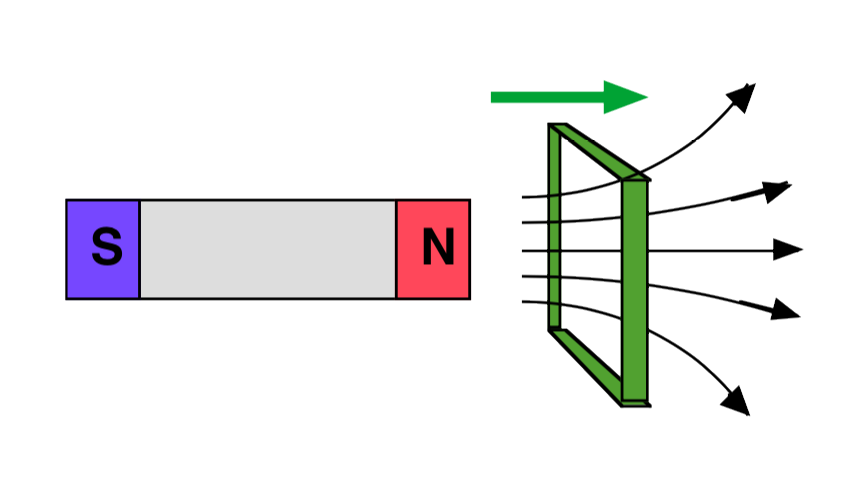
- Magnet stationary with magnetic field to the right, conducting loop (green) moving to the left
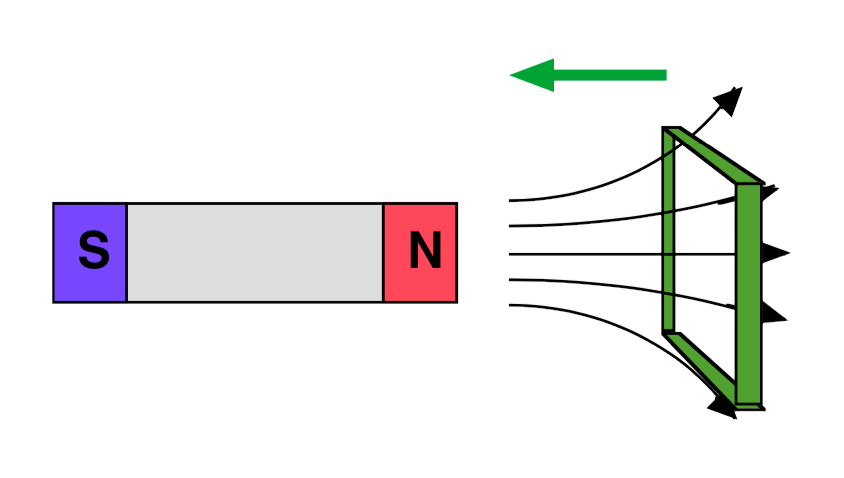
- Magnet stationary with magnetic field to the left, conducting loop (green) moving to the left
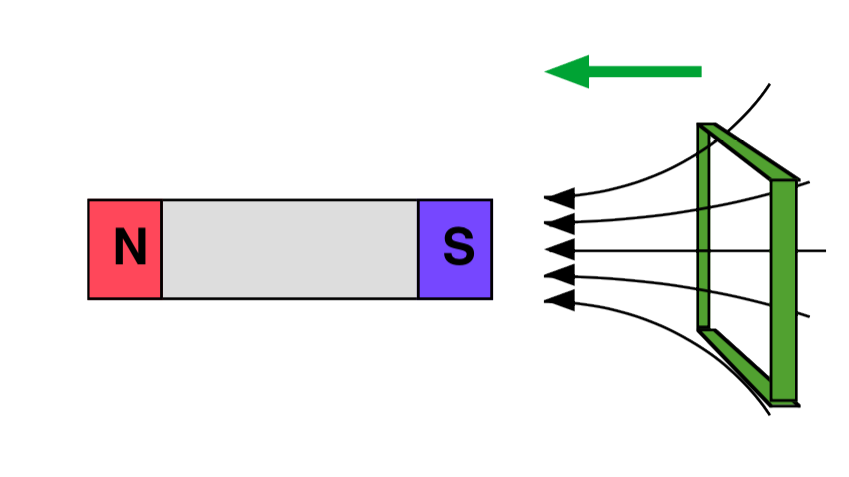
- Rotating conducting loop, loop area in B field getting smaller

- Rotating conducting loop, loop area in B field getting larger

- Down in front, up in back
- Up in front, down in back
- Down in front, up in back
- Down in front, up in back
- Up in front, down in back
More Lenz's Law Practice

Examine the following diagram. Find the direction of the induced current in the loop:
- at the instant the switch is closed
- after the switch has been closed for several seconds
- when the switch has been opened again
- When switch is closed, current begins to flow in loop, creating increasing magnetic field to left. To oppose this change in flux, current in the loop is induced in a "down in front, up in back" direction.
- When switch has been closed for several seconds, no more current flows in the loop, because there is no more change in magnetic flux.
- When the switch is opened again, the magnetic field to the left begins to decrease. Loop current opposes this decrease by having a direction that is in the same direction as the magnetic field, ie."up in front, down in back."
13.1.2. Induced EMF and Electric Field
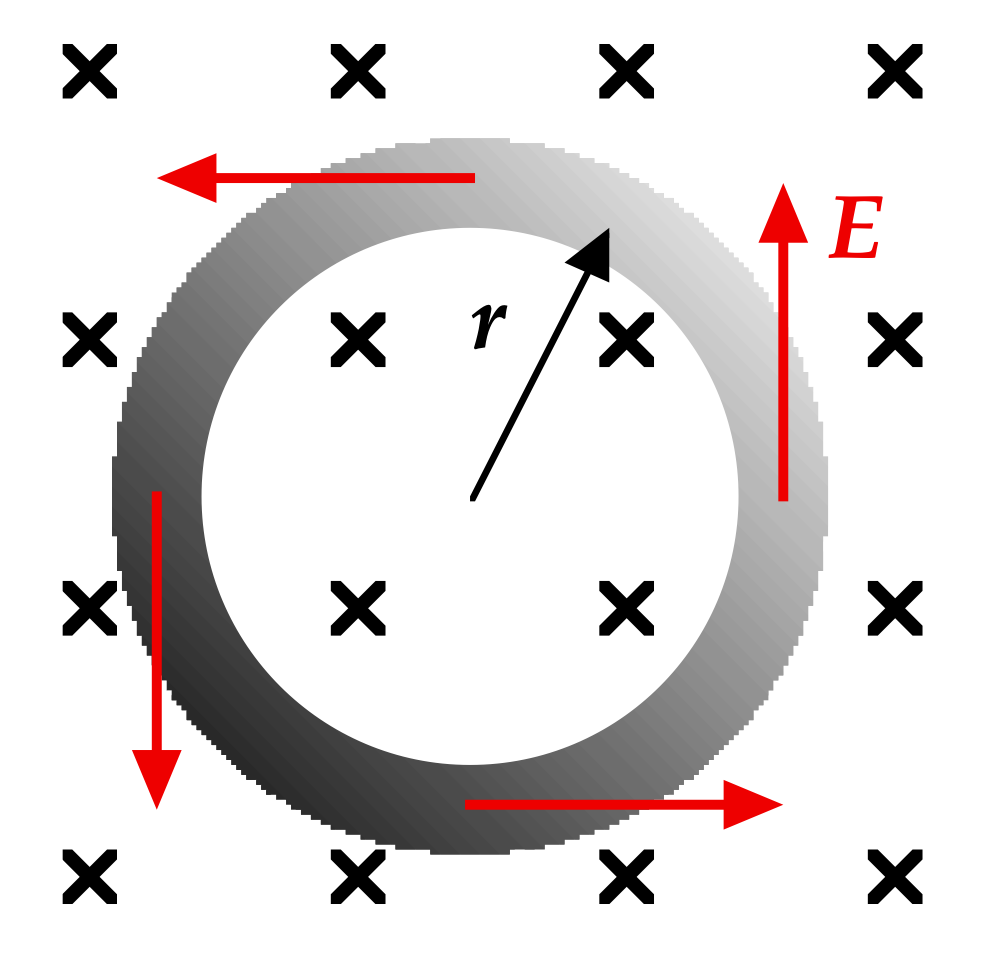
We've determined that a changing magnetic flux induces an emf and a resulting current flow in a conducting loop, so... an electric field must be present in the conductor. We can't analyze that electric field using our electrostatic analysis because in those situations, the electric field E was conservative. Here, as charges move around in the circle, , so the induced electric field E is non-conservative.
Definition: Faraday's Law, Revised
A changing magnetic flux through a conductor produces an emf that is associated with a time-varying, non-conservative electric field E.
Time-varying electric field
For a conducting loop of radius r exposed to a time-changing magnetic field B oriented perpendicular to the plane of the loop, determine the magnitude of the changing electric field E in the conductor.
13.2. Applications
Electromagnetic induction isn't just an esoteric physics topics—it is used dozens of applications, from your electric toothbrush to your phone charger, from the outlets in the walls of your house to electric guitars.
You wouldn't even be sitting in a well-lit room reading this on a computer without Faraday's Law of Induction providing you with the power to light your lights and operate your computer.
Here are some ways that law works in some devices around us.
13.2.1. Ground Fault Interrupter

A ground-fault interrupt (GFI) is a strategy for cutting off the current to a circuit in an emergency.

- Ordinarily, there is no net current enclose by gray loop, so there is no magnetic field around the wires, and the green coil wrapped around the grey loop has no emf or current.
- If there’s a ground fault (current going through the coil and into a person, for example, but not coming back through the circuit), Ampere's Law results in a magnetic field in the gray loop, increasing flux, and inducing an emf in the green coil that activates a circuit breaker, cutting the circuit.
Typically, a GFI will cut the power to a circuit within 25-40 milliseconds, preventing significant amounts of current from entering a person's body, where it risks interfering with the fibrillation activity of the heart.
13.2.2. Electric guitar pickups

An acoustic or classical guitar has vibrating strings that cause the hollow-body of the guitar to resonate as well, which physically moves air molecules in an area that are picked up as sound by ears.
Some acoustic/classical guitars have a small microphone that picks up the sound waves, converts those vibrations to electrical signals, and delivers them to an amplifier which moves a large speaker at the same rate as the guitar string, increasing the volume of the sound without changing its frequency.
An electric guitar, however, has "pickups" that convert the sound to electrical signals for transmission to the amplifier.
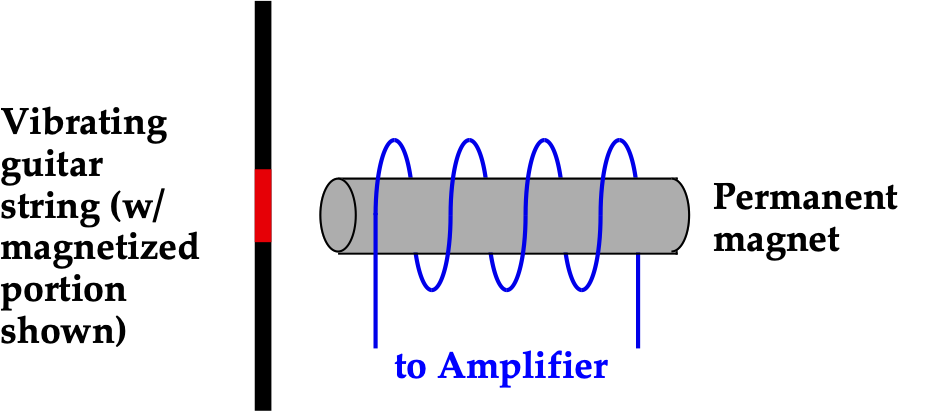
- A small magnet in the pickup sits below each metal string, magnetizing the section of the string just above it.
- When the magnetized string begins to vibrate, a nearby coil experiences a change in magnetic flux at the same frequency as the string. This changing flux produces an emf/current which is transmitted to the amplifier.
13.3. Motional EMF
Related to the idea of an emf produced by a changing magnetic flux, there is an emf produced by the motion of a conductor through a magnetic field, or motional emf.
Definition: Motional EMF

When we move a conductor through a magnetic field, motional emf occurs. Consider the conducting rod moving through a magnetic field as shown here. What happens to charges in the conductor as the rod moves to the right?
"Free charges" in the conductor have a velocity as a result of being moved through the magnetic field, so they have a velocity v, and thus experience a magnetic force:
By the Right-Hand Rule, this causes positive charges to be forced upwards in the rod, with negative charge downwards. This separation of charges causes there to be an electric field set up in the rod, away from positive charges (downward), and this field applies an electrical force to counter the magnetic force.
Charges will continue to migrate upwards due to the magnetic force until the magnetic force up and the electric force down are in dynamic equilibrium.
At this point there is an electric potential difference between the upper and lower ends of the rod that we can calculate:
This is an interesting result that doesn't require any knowledge of magnetic flux to understand. But let's see what happens to that same example if we set the conducting bar as a moving component of a circuit.
Moving conductor in a circuit, part 1
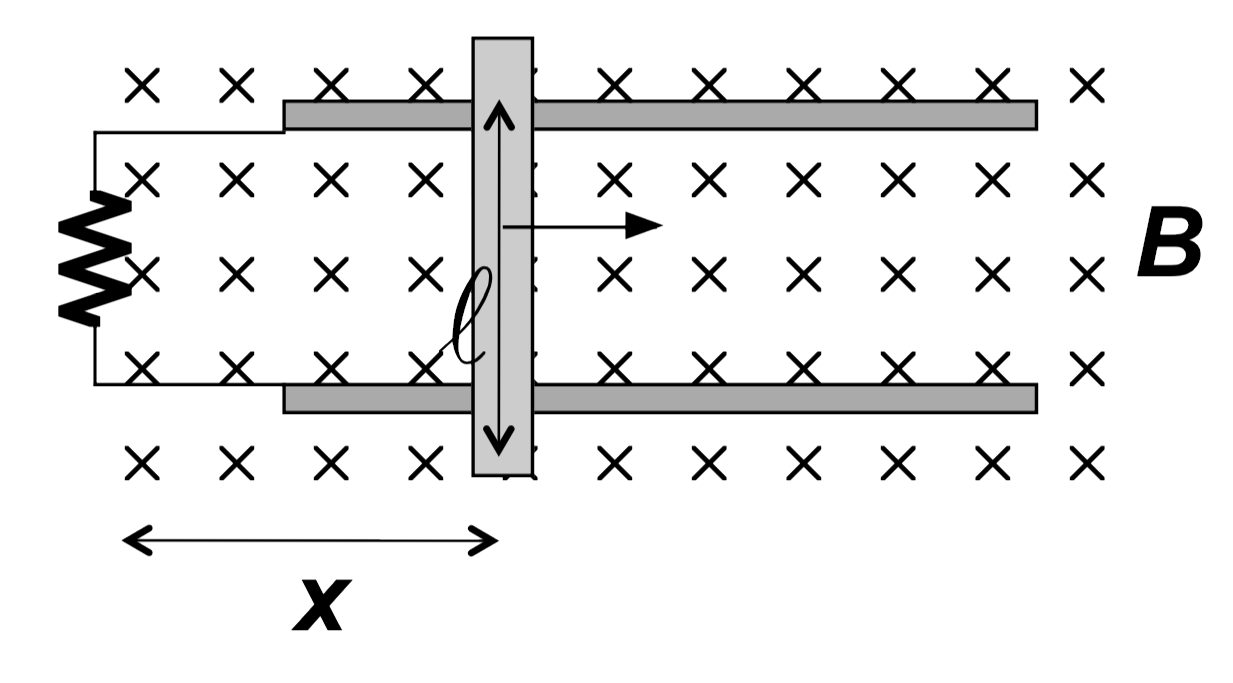
This conductor, moving to the right with a velocity v is sliding on conducting rails that are connected by a resistor, making a conducting loop. According to Faraday's Law of Induction, changing flux through that loop will induce an emf. Identify the emf in the circuit as a function of the quantities given.
Notice that this result is the same that we arrived at in using motional emf in the previous example.
Moving conductor in a circuit, part 2 - Lenz's Law

What direction is the current flowing in this loop?
- Determine direction of magnetic field: "into the page"
- Determine whether flux in the area is increasing or decreasing: "increasing" as the area gets larger
- Use RHR, with thumb pointing in opposite direction of increase—"out of the page"—to determine direction of current flow: "clockwise", or "up" in the bar.
As we're moving that bar with a velocity v across the magnetic field, the emf causes a current to move through the bar... and a current-carrying conductor in a magnetic field experiences a magnetic force!
Let's try to calculate how much force, how much Power it takes to make it all happen, and how much Power gets dissipated by the circuit.
Moving conductor in a circuit, part 3

As we move the current-carrying bar through the magnetic field, there’s a magnetic force that acts on it. If we move the bar with a constant velocity v across conducting rails with negligible friction, calculate
- the magnetic force acting on the bar
- the power we're using to move the bar
- the power dissipated by the circuit
We've already determined that the emf induced in the circuit is Blv. With that in mind:
- The magnetic force acting on the bar is
- the power we're using to move the bar
- the power dissipated by the circuit is
Note that the Power applied to the experiment and the Power dissipated by the circuit are the same! Conservation of Energy!
Let's see one more interesting application of this experimental set-up.
Give it a shove

A bar of mass m and length l is given an initial velocity v0 and released so that it slides on two parallel frictionless rails in the presence of a magnetic field B as shown, with load resistance R attached. Although there is no friction force opposing the motion, there is a magnetic force in the opposite direction of v. Calculate v as a function of time t.
The magnetic force acting on the current induced in the bar acts in the opposite (negative) direction of the velocity:
Manipulate the equations to isolate v on one side and t on the other, and then integrate with respect to those two variables:
or:
13.4. Eddy Currents
If changing magnetic flux produces emf and currents in a circuit, those same changes in magnetic flux can induce eddy currents (circulating free charges in a bulk metal moving through a magnetic field).
Eddy currents

In the example shown here, a flat conducting rectangle is attached to a pendulum arm, and is swinging down into a gravity field. As free charges in the metal enter the magnetic field, they are forced upwards in the conductor, resulting in a circular flow of charge in the rectangle. The current in the part of the conductor that is in the magnetic field is subjected to a magnetic force according to F = Il × B, in opposition to the motion of the pendulum's arm.

What happens as the flat conducting rectangle begins to leave the magnetic field on the opposite side?
Because eddy currents produce retarding forces, they can be used in as braking systems for mass transit systems. If eddy currents are not desired, then the bulk metal is often split into thin layers that are laminated together.